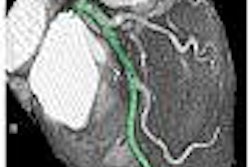New research has pierced the long-held belief that chest x-rays indicate how recently a patient has been infected with tuberculosis. But the results also suggest that radiographs have a more clinically important role in spotting the "atypical" findings seen in TB patients who also have human immunodeficiency virus (HIV).
"We recommend in places like New York that anybody with TB be HIV-tested anyway," said Dr. Neil Schluger, a pulmonologist and lead author of the new study. "But I think if (radiologists) see certain patterns, particularly in adults, they should think about HIV or other immuno-compromised states."
Schluger and his colleagues from the Columbia University Medical Center in New York City published their findings on radiographic correlations in tuberculosis in a recent TB-focused issue of the Journal of the American Medical Association (June 8, 2005, Vol. 293: 22, pp. 2740-2745).
Their retrospective analysis involved a series of 456 patients treated between 1990 and 1999 who had at least one TB-positive respiratory culture and radiographs available.
In the radiographs, the researchers looked for the presence or absence of six features: upper lobe infiltrate, cavitary lesion, adenopathy, effusions, lower or middle lung zone infiltrate, and miliary pattern.
(As an aside, Schluger said in an interview with AuntMinnie.com that he agrees with criticism of the term "infiltrate" as nonspecific jargon, but that his study simply adopted standard terminology.)
Typical radiographs were defined as those with either an upper lobe infiltrate or a cavitary lesion in the upper lung zones, regardless of other findings. Overall, 60% of the patients in the series had typical radiographic findings, with 58% demonstrating an upper lobe infiltrate.
Atypical radiographs were those with lymphadenopathy, lower or middle lobe infiltrates, or effusions. "Radiographs with a cavitary lesion in the middle or lower lung zones were considered atypical," the authors wrote.
Using more recently developed molecular fingerprinting techniques, the researchers then conducted a DNA analysis of Mycobacterium tuberculosis cultures from all the patients. That enabled investigators to divide the TB infections into two categories: strains of TB found in only one person, and strains found in a cluster of cases.
"Clustered cases were assumed to represent recent transmission, whereas a unique case was considered to result from the reactivation of latent disease," the authors noted.
But when the researchers attempted to relate those findings with the radiographic patterns, they found little correlation.
"Although a clustered fingerprint, representing recently acquired disease, was associated with typical radiograph in univariate analysis (odds ratio, 0.68; 95% confidence interval, 0.47-0.99), the association was lost when adjusted for HIV status," the authors wrote.
Similarly, the authors reported, "When the relationship between cluster status was stratified by HIV status, several strong and significant associations became evident."
"In both groups of patients with clustered and unique strains, HIV infection was associated with fewer cavitary lesions, fewer upper lobe infiltrates, more lymphadenopathy, and fewer typical patterned radiographs," they wrote.
Just over half (52%) of the TB isolates from the 456 patients were part of molecular epidemiologic clusters. Altogether there were 51 separate clusters with a mean of 5.2 patients per cluster.
The authors noted that their findings confirmed and strengthened those from a smaller, earlier study that also found no difference in the radiographic presentations of primary and reactivated TB (American Journal of Respiratory and Critical Care Medicine, October 1997, Vol. 156:4, pp. 1270-1273).
The latest findings conflict, naturally, with two mid-'80s studies in radiology literature that correlated radiographic findings with the timing of infection.
"These studies, however, were conducted and published before molecular techniques were available and were limited by unreliable definitions of recently acquired disease that included both valid measures, such as documented purified protein derivative conversion to more suspect historical and even tautological radiographic findings," wrote the JAMA article authors.
In any case, the erroneous association between radiographic findings and length of infection had epidemiological and community health implications, but no relevance for treatment of individual patients, Schluger noted.
Meanwhile, in their report, the Columbia researchers attempt to explain why HIV status appears to be associated with radiographic findings.
"It seems plausible that either weakened host immune responses or more virulent pathogens could result in atypical presentations and, conversely, that less virulent pathogens may predispose to more typical presentations," the authors wrote.
"This is consistent with our finding that HIV-infected individuals have atypical radiographic findings, and could explain why drug-resistant but less virulent strains appear more typical," they concluded.
By Tracie L. Thompson
AuntMinnie.com staff writer
June 15, 2005
Related Reading
CT finds TB lesions not shown on x-ray, April 21, 2005
Tuberculosis risk high among Indian resident physicians, November 15, 2004
U.K. says tuberculosis has regained upper hand, October 7, 2004
Tuberculosis: Managing an old disease with modern medicine, August 12, 2004
SARS screening reveals TB in Taiwanese healthcare workers, April 23, 2004
Chest X-ray not necessary to detect active TB in HIV-infected patients, November 7, 2003
Copyright © 2005 AuntMinnie.com



















